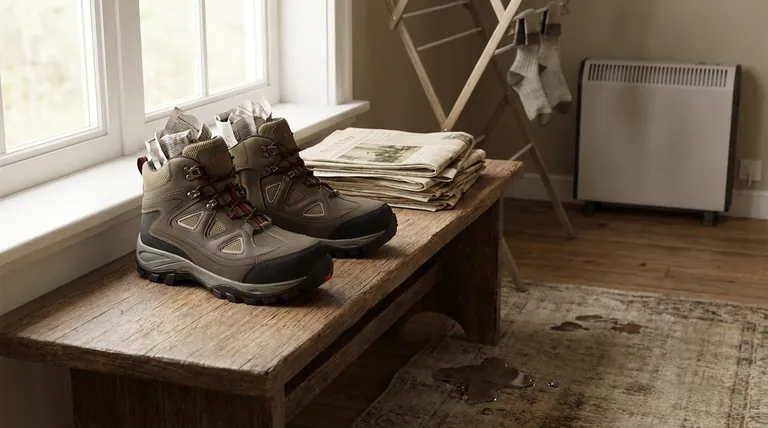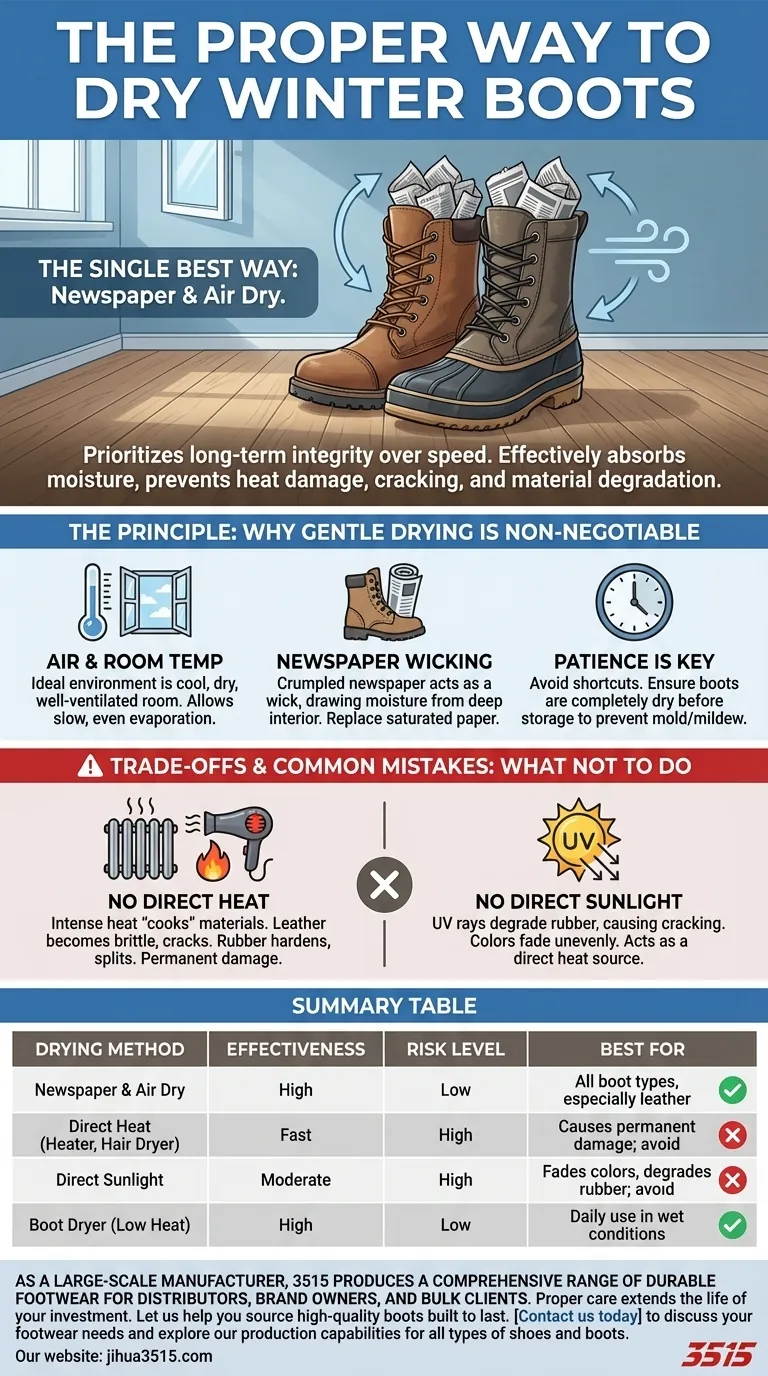The single best way to dry winter boots is to stuff them with crumpled newspaper and let them air dry naturally at room temperature, away from any direct heat source. This method effectively absorbs internal moisture while preventing the heat damage that can crack leather, degrade rubber, and ruin your investment.
The core challenge in drying boots is removing moisture without damaging the materials. While direct heat seems faster, it causes irreversible harm. The correct approach prioritizes the long-term integrity of the boot over the speed of drying.

The Principle: Why Gentle Drying is Non-Negotiable
Your boots are made from materials—leather, rubber, and synthetic fabrics—that are vulnerable to rapid temperature changes. The goal is to create an environment that encourages evaporation without shocking these materials.
The Role of Air and Room Temperature
The ideal drying environment is a cool, dry, and well-ventilated room. This allows moisture to evaporate from the boot surfaces slowly and evenly.
Placing boots in an open area is far more effective than leaving them in a cramped closet or mudroom where air cannot circulate.
Using Newspaper to Wick Away Moisture
Stuffing boots tightly with crumpled newspaper is a highly effective technique. The paper acts as a wick, drawing moisture out from the deep interior of the boot.
If the boots are heavily saturated, you may need to replace the damp newspaper with a fresh batch after a few hours to continue the process. This also helps the boots maintain their proper shape as they dry.
Understanding the Trade-offs and Common Mistakes
Many common "shortcuts" for drying boots will significantly shorten their lifespan. Understanding what not to do is as important as knowing what to do.
The Danger of Direct Heat
Never place your boots near a radiator, fireplace, heater, or use a hair dryer on them. Intense, direct heat literally "cooks" the materials.
For leather, this process draws out natural oils, causing it to become brittle and crack. For rubber components, it can cause them to harden and split. This damage is permanent.
The Problem with Direct Sunlight
While it may seem natural, drying boots in direct sunlight is also damaging. UV rays can degrade rubber, making it less flexible and prone to cracking.
Sunlight also acts as a direct heat source and can cause the colors of your boots to fade unevenly.
The Consequence of Improper Storage
Never store boots while they are still damp. This traps moisture, which compromises the effectiveness of the insulation and can lead to the growth of mold, mildew, and odor-causing bacteria.
Always ensure boots are completely dry before putting them away for the season in a cool, dry place.
Choosing the Right Method for Your Goal
Your drying strategy should be based on how frequently you use your boots and the materials they are made from.
- If your primary focus is preserving expensive leather boots: Always use the newspaper and air-dry method, as leather is the most susceptible to heat damage.
- If you have rubber or synthetic boots: The main priority is avoiding direct sun and high heat, which can make the materials brittle.
- If you wear your boots daily in wet conditions: Consider investing in a low-heat, forced-air boot dryer, as this is the only safe mechanical device for speeding up the process without causing damage.
Properly drying your boots after every use is the most critical step in maintaining their performance and protecting your investment.
Summary Table:
| Drying Method | Effectiveness | Risk Level | Best For |
|---|---|---|---|
| Newspaper & Air Dry | High | Low | All boot types, especially leather |
| Direct Heat (Heater, Hair Dryer) | Fast | High | Causes permanent damage; avoid |
| Direct Sunlight | Moderate | High | Fades colors, degrades rubber; avoid |
| Boot Dryer (Low Heat) | High | Low | Daily use in wet conditions |
As a large-scale manufacturer, 3515 produces a comprehensive range of durable footwear for distributors, brand owners, and bulk clients. Proper care extends the life of your investment. Let us help you source high-quality boots built to last. Contact us today to discuss your footwear needs and explore our production capabilities for all types of shoes and boots.
Visual Guide

Related Products
- Safety Footwear Wholesale Manufacturer for Custom OEM/ODM Production
- Wholesale Safety Footwear Manufacturer for Bulk & Custom OEM Orders
- Premium Wholesale Waterproof Safety Boots High Performance Protection for Industrial Markets
- High Performance Fire-Retardant Waterproof Safety Boots
- Premium Flame-Retardant Waterproof Safety Boots and Shoes
People Also Ask
- Do snake bite boots work? Your Ultimate Guide to Effective Snake Bite Protection
- Is safety-toe as good as steel toe? Choose the Right Protection for Your Job
- What are the differences between steel toe, composite toe, and alloy toe Wellington boots? Choose the Right Safety Toe for Your Job
- How do safety shoes contribute to cost savings for companies? A Strategic Investment in Risk and Cost Management
- What are the cultural perspectives on wearing shoes in the house? A Guide to Home Etiquette & Hygiene



















